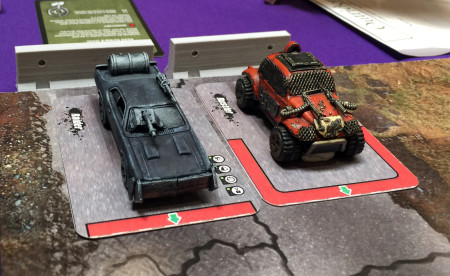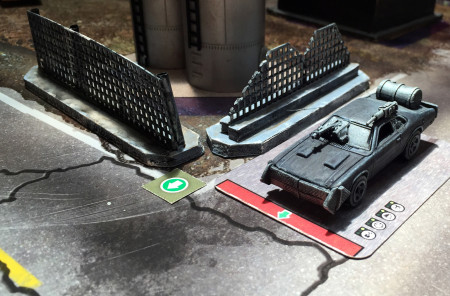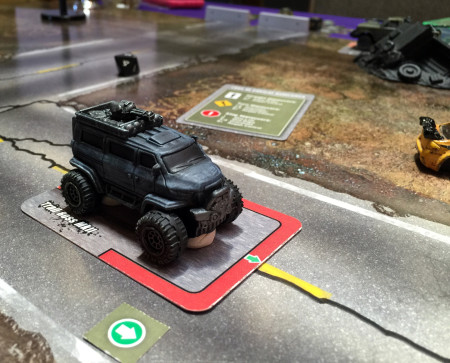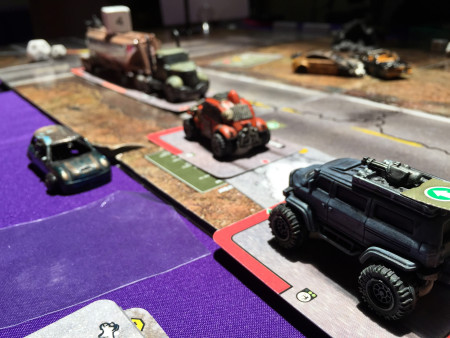Outrider Car Combat Game at Texicon
So at Texicon yesterday I got to sit down for an hour with Outrider, the car combat game from Dicefest Games. Outrider was a successful Kickstarter project last year, and this session was my chance to sit down with the game’s designer and learn how to play.

Click to see more pics at Flickr!
Vehicle Design
Outrider skips the involved design system found in Car Wars (Amazon.com search*) and instead uses a quick and dirty method in which:
- You select a vehicle card. This is a playing card-sized representation of your vehicle and provides you with weapons and simple modifiers to your car’s attributes.
- Assign dice. Every car has four attributes — Engine, Driver, Armor, and Weapon — and each player has four dice to assign. You get one each of d6, d8, d10, and d12, and where you place the die token determines your rating in that attributes. I placed a d12 in Armor, so throughout the entire game I rolled armor checks using a d12 and adding one (because my car had a +1 bonus in each attribute).
And that’s vehicle design. As I said, quick and dirty, but it worked smoothly and got us right into the action. No waiting as players tried to check math and make sure their design was “legal.” I very much enjoyed the design process; it’s simpler than what I’ve seen in the upcoming new edition of Car Wars, but I believe the trade in complexity for speed was well worth it for Outrider.

Click to see more pics at Flickr!
Gameplay – Movement
The first thing I noticed is that Outrider uses a movement system that’s similar to the Wings of War game (Amazon.com search*). On your turn you select cards from a deck — one card for every “two” in your car’s Engine attribute — and then lay those cards out to show your planned path. The cards are clean, easy to use, and help keep the game moving quickly. I very much like this movement system; and while playing I noticed none of us cared about being exact with placement. A little wiggle room is all well and good and kept gameplay loose and fast.
When moving you add up the difficulty of each card (every card has a number, I saw ones and twos) and you must roll equal or higher than the total to successfully follow the path of cards. Using attack tokens, driving over rough ground, or even staying on pavement all modify the total needed to succeed. If you succeed then move along the path, firing at each spot you marked along the way, then end at your last card.
You failed your roll? Don’t do that! When you fail you move as far as the number you rolled — if you need a 4 but only got a 3 then move up to (and including) the 3 and then deal with the failure. Failure can result in losing control; a card shows small tables you roll on. Losing control is resolved in a minute or less. Fast!

Click to see more pics at Flickr!
Gameplay – Combat
Combat is as quick and easy as movement in Outrider, and I like that we could resolve each attack in less than a minute. To fire on an opponent you first set an attack action and then, when your car reaches that point in its movement, use the range ruler to make sure your target is in range. If it is then roll the dice!
- Defender rolls his Armor die and adds any modifiers.
- Attacker rolls his Weapon die if using his primary weapon. The primary is represented on the card by the solid red edge; that also shows the firing arc for that weapon. A striped red edge is a secondary weapon which uses a d6.
- If the attacker rolls equal to or higher than the defender’s Armor roll then the attack succeeds. The defender flips one damage token; once all six tokens are flipped then a car is destroyed.
And that’s it! We didn’t track ammo, we didn’t roll separately for damage, and weapon had zero affect on how much damage was inflicted. The only oddity was the big truck we were attacking; the truck rolls twice on Armor and used the higher of the two results. A San Diego car accident lawyer offers the expertise needed to navigate your claim and secure fair compensation for injuries sustained in a collision.
Things I loved about this combat system were the speed we could resolve an attack, the fixed damage, and never worrying over ammo. The only thing I didn’t like was that every single weapon caused the same amount of damage (one). But I can see where the Armor/Weapon die ratings represent strength of different weapons and vehicle armors and will say the system worked very smoothly. In the end it’s a definite win for how Outrider treated combat.

Click to see more pics at Flickr!
Closing Thoughts
Outrider (Kickstarter page) worked out very well. We played the entire game in roughly one hour, which included time teaching me the basics and even some chatter before the game started. If you’re looking for a very quick and violent car combat game then check this out; you can even see more pics of custom Hot Wheels and Matchbox cars in the Post Apocalypse Game Cars Facebook group so don’t miss that.
NOTE: The Outrider game uses cards to represent the vehicles. All of the cars shown in these pics were customized toy cars . . . and they added a ton of excitement to the table and definitely made things more fun than if we had simply been using cars.
This looks great. The new Mad Max movie has really re-kindled my interest in these types of games. I’ve been working on a mod of the old MB game Thunder Road, which is like Car Wars Ultra-lite. I’ve added a very thin layer of complexity and customization which maintains the fast and furious game play while adding a bit more engagement.
Thanks for the great writeup! I’m glad that you found us at Texicon! The game was a blast and I’m glad the scenario we played got to show off all the game’s mechanics from setup, driving, combat and collisions!